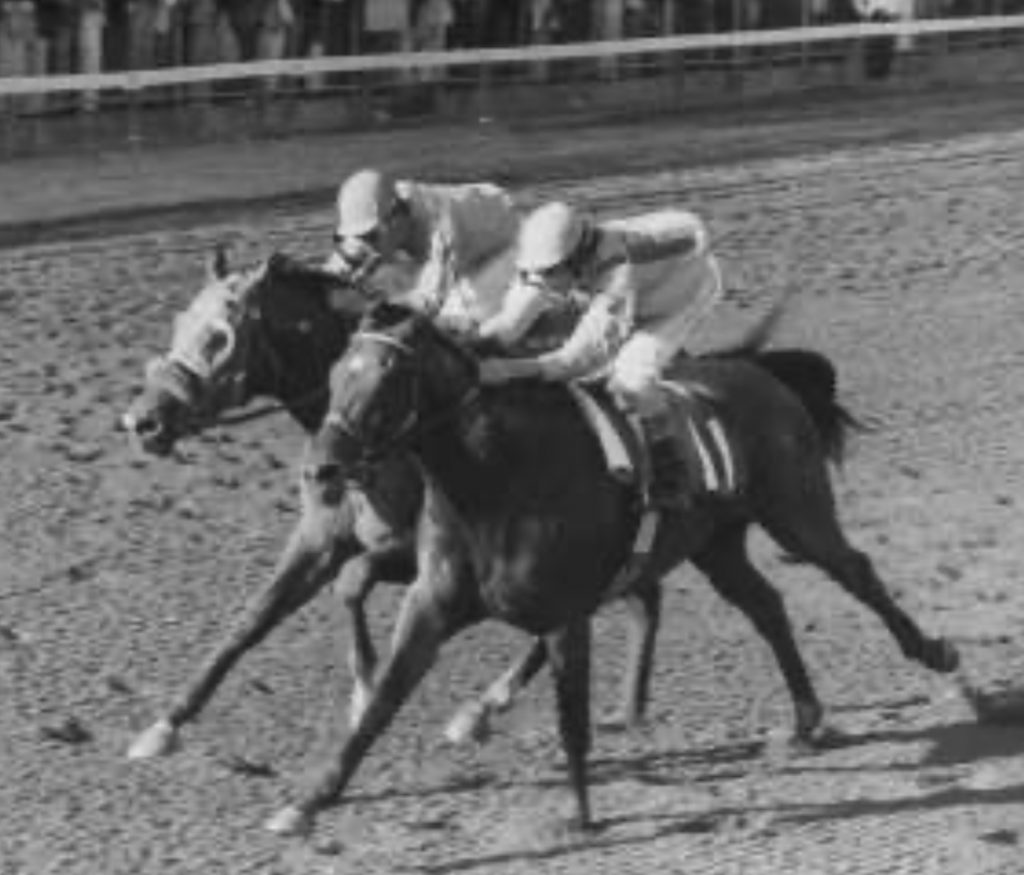
Do you know who Ralph Metcalfe is? He finished second to Jesse Owens in 100 meters at the 1936 Olympics. What about Christopher Chataway? He ran a valiant second to Roger Bannister when Bannister broke the four-minute mile barrier in 1954.
History remembers second-place finishers. The same can be said for poor Run Dusty Run, who finished second to the great Seattle Slew in 1977 in two of the three Triple Crown races.
Trained by W.E. “Smiley” Adams, Run Dusty Run made his debut in the third race at Keeneland on Tuesday, April 6, 1976, finishing an unimpressive eighth. He broke his maiden a little more than a week later at Keeneland, and then won his first stakes race, the Arch Ward Stakes, at Arlington in September and turned heads with victories in the rich Arlington-Washington Futurity, the Breeders’ Futurity and the prestigious Kentucky Jockey Club Stakes.
Second Place Starts to Get Familiar
Ridden by Darrel McHargue, his style was developing; he preferred to come from off the pace, often in the homestretch, and overtake his rivals in the final furlong. With four stakes victories, he was favored by some to be Two-Year-Old Colt of the Year.
But he lost out to the undefeated Seattle Slew, who had run only three times that year but had taken the Champagne Stakes by nearly 10 lengths. Run Dusty Run had won six of nine races.
In the Experimental Handicap, a fictional race in which horses are given weights based on their performance, both Run Dusty Run and his rival Royal Ski received 125 pounds to Slew’s 126. It was good enough for second; he was a true contender for the Kentucky Derby.
Run Dusty Run waited until March for his first prep race; Adams complained that he couldn’t find a good warm-up race for the Florida Derby, so he sent the colt to the Fair Grounds in Louisiana, where he won an allowance race.
He followed that up with a win in the Louisiana Derby Trial March 5. The 2-5 favorite won by 3/4 of a length over Clev Er Tell, but Clev Er Tell got his revenge, posting an easy 2 1/2-length upset over Run Dusty Run in the Louisiana Derby after the latter got bumped at the half-mile pole.
Adams ran his colt in the Calumet Purse at Keeneland on April 19, but he got nipped at the wire by Giboulee, who had been jostled by Run Dusty Run throughout the entire homestretch. McHargue waved off the performance, claiming that Run Dusty Run was “sorta playing” and had a tendency to do that with other horses in the stretch.
The losing continued. Run Dusty Run finished second to For the Moment in the Blue Grass Stakes just nine days before the Kentucky Derby, losing by 1 3/4 lengths despite his come-from-behind strategy. He would now run into a buzzsaw at Churchill Downs; Seattle Slew had still not lost, going unbeaten in three starts in 1977 and running his record to a perfect 6-0.
‘A Good Sham’
The Derby was run on May 7 of that year – the latest it could be run. Seattle Slew, the 1-2 favorite, broke slowly and had to work his way up to the front, being challenged by For the Moment. Slew began to draw away entering the homestretch and waited for Run Dusty Run.
Here he came, right on schedule, but the son of Dust Commander didn’t have enough in the tank to catch Seattle Slew. “I thought I had Seattle Slew at the head of the stretch,” McHargue said of his colt. But in the end, Slew won by a comfortable 1 3/4 lengths over Run Dusty Run.
Jack Murray of the Cincinnati Enquirer said Run Dusty Run was “playing a good Sham to Seattle Slew’s Secretariat.”
In the Preakness, Run Dusty Run couldn’t run fast enough. Seattle Slew cruised to victory by 1 1/2 lengths over Iron Constitution, who was 2 lengths ahead of the Adams colt. Adams was not happy with McHargue’s ride, complaining that the jockey “had him all over the race track, out, in, back, then jumped back and wound up on the inside.”
The trainer was serious. Before the Belmont, he replaced McHargue with Sandy Hawley. But Run Dusty Run could still do no better than second, as Seattle Slew led wire to wire and cruised to a four-length victory over the tiring colt.
Second place seemed to fit Run Dusty Run; he finished his career with 10 wins, 10 seconds and 1 third in 24 starts. His worst year was actually his three-year-old season, where he won only two of 12 starts, finishing second eight times.
As a four-year-old, he won two out of three races, including the Hialeah Challenge Cup Invitational Stakes and the Seminole Handicap.
As good as Sham? Maybe not. But if it weren’t for Seattle Slew, we might be talking about Run Dusty Run as a great horse instead of a footnote in horse racing history.


